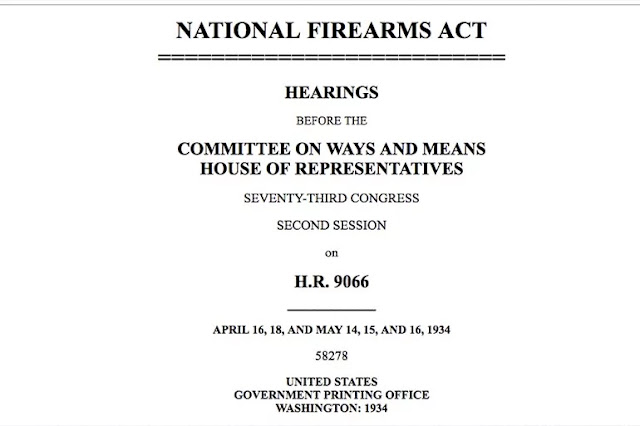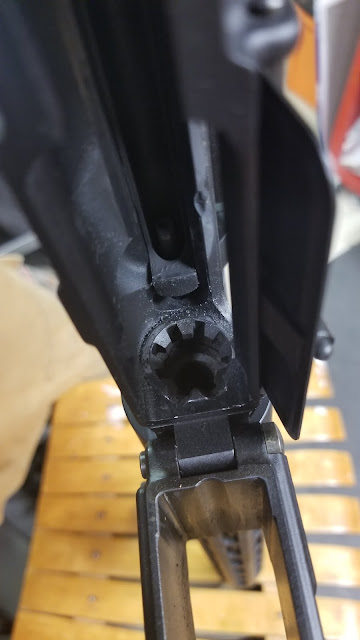A Brief Introduction to the NFA
Introduction:
I will preface this by saying that I am not a lawyer and nothing that you read here should be taken as legal advice or anything of the sort. I am writing this just for some basic information and I'm sure there are legal aspects of the NFA that I don't understand. If you have any legal questions, ask a lawyer, not some guy writing a blog.
The National Firearms Act (NFA) is a series of laws that was originally passed in 1934 that classified and placed regulations on various types of firearms and accessories. These include machine guns, short-barrels rifles, short-barreled shotguns, suppressors, and destructive devices. I'll go into what these all mean later, but the NFA regulates the purchase of these, requiring the would-be purchaser to pay a tax and register the firearm. The NFA has been amended and added-to over the years, so there are a lot of firearm category-specific rules that firearm owners should be aware of.
Short Barreled Rifles
A short barreled rifle (SBR) is an NFA classification that covers firearms with a stock and a rifled barrel with a length of less than 16 inches, or an overall length of less than 26 inches. For reference, a standard military-issue M4A1 has a 14.5 inch barrel. A large majority of SBRs are made from AR variants. Many "CQB" style rifles such as MK18 or CQBR type rifles can qualify as SBRs. However, because of the legal definition of what a rifle is, there are some firearms that are technically SBRs that seem weird.
 |
| Source: https://www.invaluable.com/auction-lot/glock-model-17-short-barrel-rifle-with-shoulder-s-216-c-78e45d0845 |
So the picture above is a normal Glock 17 that simply has a shoulder stock added onto it. Because part of the definition of a rifle is that it is designed to be fired from the shoulder, this Glock has been turned into a rifle. On top of this, because of the Glock's pistol-length barrel, this Glock is now a short-barrel rifle and requires the payment of a $200 tax in order to possess it.
Now whereas this Glock is now an SBR, if someone wishes to have themselves a MK18, all they would need to do is buy and AR pistol and add an arm brace where a stock would normally go. From my limited understanding, this skirts the law because the brace is not designed to be shouldered, so it allows the firearm to be classified as a pistol.
 |
| Source: https://www.usconcealedcarry.com/blog/keeping-your-ar-15-pistol-build-within-legal-limits/ |
While the Glock is a rifle, the AR above is a pistol. This goes to show how people will find any way to work around firearms laws. When the NFA was passed in the 30's there was no such thing as an intermediate cartridge along the lines of .223 or 5.56. This means that this ordeal was not something that people at the time thought could be an issue. The rule was written at a time where an SBR was a .30-06 BAR that was cut down with a hack saw.
NFA Workarounds
The most popular workaround to NFA regulations is the pistol brace. Pistol braces are typically designed to give a cosmetic look similar to a buttstock, but are not designed to be shouldered. Depending on the model of firearm, there are fixed, collapsible, and folding braces to choose from depending on what you're going for.
One NFA workaround became so popular and was so good that President Trump actually directed the ATF to re-define machine guns in order to make the workaround illegal. This was, of course, the bump-stock.
 |
| Source: https://files.osgnetworks.tv/2/files/2014/01/slide_fire_sbs_308_stock.jpg |
The bumpstock was designed to add just the slightest amount of practicality to what has always been a bit of a range track. People have been bumpfiring since the existance of both semi-auto rifles and belt loops. What the bump-stock did was it allowed the shooter to halfway-effectively shoulder and fire a semi-auto rifle rapidly. The idea is to allow a shooter to attempt to replicate automatic fire. The stock works via the rifle riding within the stock. The rifle is pulled forward by the shooter, the trigger is the pressed as part of that, and then the rifle rides back through recoil. With practice, a shooter can bumpfire the rifle. The obvious downside to this is that it is incredibly inaccurate.
The bumpfire stock's entry into the mainstream is what caused it to be banned. It's use by the Las Vegas shooter caused it to be plastered over media outlets. Because many people outside the firearms community were unfamiliar with the limitations and ineffectiveness of bumpstocks, they pushed harder against them being allowed for average citizens.
Conclusion
Now I didn't go over every classification in the NFA or too in depth, but I jsut wanted to point out some of the odd things surrounding the NFA. The workarounds and backwards-seeming definitions are important to be aware of. They're important because, in my opinion, it is important to question the NFA and its effectiveness is actually reducing the effectiveness of weapons used by criminals. There seems to be no reason that a pistol can't have a stock while an AR with a brace is a pistol that falls under the same regulations as a Glock.


Comments
Post a Comment